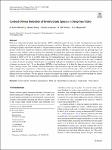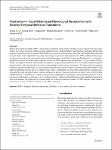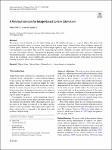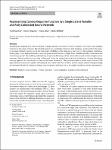Search
Author
- Osman, Ahmed I. (5)
- Daqing, Ma (3)
- Jorgensen, Ed (3)
- Li, Yan (3)
- next >
Subject
- kinh tế (26)
- Economics (12)
- programming (10)
- XRD (10)
- next >
Date issued
- 2020 - 2025 (2128)
- 2010 - 2019 (129)
- 2000 - 2009 (9)
- 1999 - 1999 (1)
Has File(s)
Search Results
Each year, underwater remotely operated vehicles (ROVs) collect thousands of hours of video of unexplored ocean habitats revealing a plethora of information regarding biodiversity on Earth. However, fully utilizing this information remains a challenge as proper annotations and analysis require trained scientists’ time, which is both limited and costly. To this end, we present a Dataset for Underwater Substrate and Invertebrate Analysis (DUSIA), a benchmark suite and growing large-scale dataset to train, validate, and test methods for temporally localizing four underwater substrates as well as temporally and spatially localizing 59 underwater invertebrate species. |
Given a node-attributed graph, how can we efficiently represent it with few numerical features that expressively reflect its topology and attribute information? We propose A-DOGE, for attributed DOS-based graph embedding, based on density of states (DOS, a.k.a. spectral density) to tackle this problem. A-DOGE is designed to fulfill a long desiderata of desirable characteristics. Most notably, it capitalizes on efficient approximation algorithms for DOS, that we extend to blend in node labels and attributes for the first time, making it fast and scalable for large attributed graphs and graph databases. |
Swarm intelligence leverages collective behaviours emerging from interaction and activity of several “simple” agents to solve problems in various environments. One problem of interest in large swarms featuring a variety of sub-goals is swarm clustering, where the individuals of a swarm are assigned or choose to belong to zero or more groups, also called clusters. In this work, we address the sensing-based swarm clustering problem, where clusters are defined based on both the values sensed from the environment and the spatial distribution of the values and the agents. |
Remote photoplethysmography (rPPG), which aims at measuring heart activities and physiological signals from facial video without any contact, has great potential in many applications (e.g., remote healthcare and affective computing). Recent deep learning approaches focus on mining subtle rPPG clues using convolutional neural networks with limited spatio-temporal receptive fields, which neglect the long-range spatio-temporal perception and interaction for rPPG modeling. In this paper, we propose two end-to-end video transformer based architectures, namely PhysFormer and PhysFormer++, to adaptively aggregate both local and global spatio-temporal features for rPPG representation enhancement. |
In-situ visual observations of marine organisms is crucial to developing behavioural understandings and their relations to their surrounding ecosystem. Typically, these observations are collected via divers, tags, and remotely-operated or human-piloted vehicles. Recently, however, autonomous underwater vehicles equipped with cameras and embedded computers with GPU capabilities are being developed for a variety of applications, and in particular, can be used to supplement these existing data collection mechanisms where human operation or tags are more difficult. |
We propose a novel minimal solver for sphere fitting via its 2D central projection, i.e., a special ellipse. The input of the presented algorithm consists of contour points detected in a camera image. General ellipse fitting problems require five contour points. However, taking advantage of the isotropic spherical target, three points are enough to define the tangent cone parameters of the sphere. This yields the sought ellipse parameters. Similarly, the sphere center can be estimated from the cone if the radius is known. These proposed geometric methods are rapid, numerically stable, and easy to implement. Experimental results—on synthetic, photorealistic, and real images—showcase the superiority of the proposed solutions to the state-of-the-art methods. A real-world LiDAR-camera c... |
Judgments concerning animals have arisen across a variety of established practice areas. There is, however, no publicly available repository of judgments concerning the emerging practice area of animal protection law. This has hindered the identification of individual animal protection law judgments and comprehension of the scale of animal protection law made by courts. Thus, we detail the creation of an initial animal protection law repository using natural language processing and machine learning techniques. This involved domain expert classification of 500 judgments according to whether or not they were concerned with animal protection law. 400 of these judgments were used to train various models, each of which was used to predict the classification of the remaining 100 judgments... |
The increasing size of deep neural networks (DNNs) raises a high demand for distributed training. An expert could find good hybrid parallelism strategies, but designing suitable strategies is time and labor-consuming. Therefore, automating parallelism strategy generation is crucial and desirable for DNN designers. Some automatic searching approaches have recently been studied to free the experts from the heavy parallel strategy conception. However, these approaches all rely on a numerical cost model, which requires heavy profiling results that lack portability. These profiling-based approaches cannot lighten the strategy generation work due to the non-reusable profiling value. Our intuition is that there is no need to estimate the actual execution time of the distributed training bu... |
Representing Camera Response Function by a Single Latent Variable and Fully Connected Neural Network Modelling the mapping from scene irradiance to image intensity is essential for many computer vision tasks. Such mapping is known as the camera response. Most digital cameras use a nonlinear function to map irradiance, as measured by the sensor to an image intensity used to record the photograph. Modelling of the response is necessary for the nonlinear calibration. In this paper, a new high-performance camera response model that uses a single latent variable and fully connected neural network is proposed. The model is produced using unsupervised learning with an autoencoder on real-world (example) camera responses. Neural architecture searching is then used to find the optimal neural network architecture. A latent distribution learning approach was introduced to constrain the latent... |
In the digital age, the use of advanced technology is becoming a new paradigm in police work, criminal justice, and the penal system. Algorithms promise to predict delinquent behaviour, identify potentially dangerous persons, and support crime investigation. Algorithm-based applications are often deployed in this context, laying the groundwork for a ‘smart criminal justice’. In this qualitative study based on 32 interviews with criminal justice and police officials, we explore the reasons why and extent to which such a smart criminal justice system has already been established in Switzerland, and the benefits perceived by users. Drawing upon this research, we address the spread, application, technical background, institutional implementation, and psychological aspects of the use of ... |









